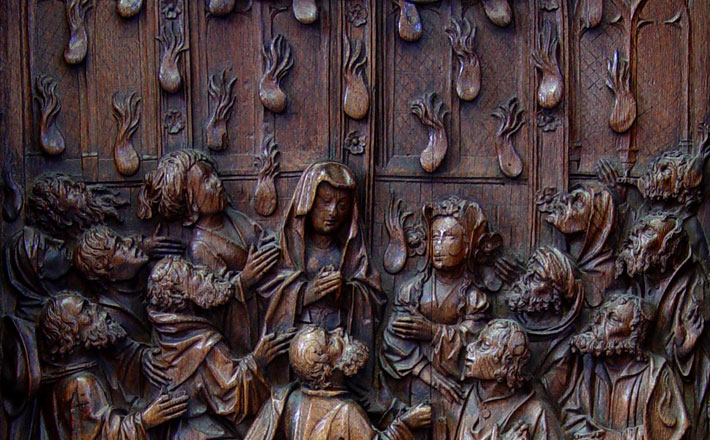Commentary on John 15:26-27; 16:4b-15
The temptation when preaching Pentecost is to make the sermon a witness to something that happened.
When we do this, we simply retell the story of Acts 2 and reconstruct the account of the Holy Spirit’s coming to the early disciples. Then we describe an event that marked the founding of the church and the enlivening of the early days of the spread of the gospel.
The challenge is to create a narrative for our preaching so that the Pentecost event is made relevant for the present in real and tangible ways. The Gospel of John (GJ) text guides us in some clear ways in how to do so from that context and into our own.
This article will steer our thinking towards understanding what the text reveals about the function of the Spirit. What is to happen when the Spirit comes? Secondly, the article will attempt to challenge us to ponder where and how we see this same activity in our community and in the world today. Jesus did not promise the Spirit as a gift only for the first and second century Christians. The reality of Pentecost is that our world at this moment is God-drenched. It is the Holy Spirit who reveals that.
The ethos of the GJ was marked by two clear groups: those inside the community (those who knew Jesus, who believed) and those outside, the “world,” (those who did not know or believe). The lines of demarcation were exact and unbending.
These verses are part of what we call Jesus’ “Farewell Discourse” to his disciples. Here the gospel writer captures Jesus’ last teaching moments with those who had followed him most closely. Jesus is intent on clarifying with them that he is about to leave this earth and return to the Father in heaven. The incarnation has been Jesus’ descent to earth, and now it is time for Jesus to ascend. He will, however, send the Spirit to them. As Jesus ascends, the Spirit will descend.
What is to happen when the Spirit comes?
The particular relevance of this passage in making our sermons speak to our own contexts is that the text states openly what the function of the Spirit will be. The author of this gospel spells out unmistakably in the words of Jesus to the disciples what the Spirit will do. In what is rather strange for the gospel context, the Spirit is going to bridge the two realms. The Spirit will function both in the community and in the world.
- For the world (John 16:8-11): The Spirit will bring the world to the recognition of the meaning and reality of sin, righteousness, and judgment. In other words, the Spirit will expose to the outsiders, to those who do not believe, the error of their unbelief. Not to believe is the greatest sin according to GJ, and that sin keeps one outside the community. The Spirit, thus, has the function of continuing to confront the world (outsiders) with the presence of Jesus after his ascension. In this way, the Spirit functions as a witness to Jesus (John 15:26) to the world and to the community, to outsiders and insiders.
- For the community: The Spirit witnesses concerning Jesus to the community as well as to the world. More significantly for the community specifically, the Spirit will lead them in the way of truth on matters that Jesus has not yet been able to teach them (John 16:13). This is interpreted in 16:14 as “taking what is mine and declaring it to you.” The exciting news in this is that the Spirit will proclaim Jesus’ own teachings in the new and changing circumstances that the community will face when Jesus is gone. The Spirit will interpret what it has heard for the new contexts that the community will come to face. The Spirit will make the teachings of Jesus relevant to each new generation and to each new age.
Where do we see the Spirit functioning in our communities and our world now?
The movement forward in the interpretive process is to articulate directly and to tease from the hearers insights into where and how the Spirit is active today.
- As I write this article in the middle of January, there are continuing conversations on our campus about the sin of broken relationships between the races. Until events in Missouri, Ohio, and New York, honest conversations about the reality of this sin among us could not happen. Among devastating circumstances we were watching others go through, the Spirit of Truth convicted our community and we began to be vulnerable and open.
- Just a few days ago, some of our students returned from an inner city cross cultural learning experience in Detroit. Most of them knew about the devastation of the city from news programs and reading about the flight from the city because of the economic downturn. However, when they had the opportunity to walk along side of the poorest of the poor and see first-hand how perilous it is for those who live on the margins, they were guided into the truth. They were also able to see and hear the message of Jesus in new and life-changing ways from the Christian servants who are committed to the residents of Detroit and are testifying to Christ among them. The Spirit is at work.
The demarcation between those who are inside and those who are outside is never quite as precise as the GJ depicts it. The work of the Spirit in the world today helps us to see that. The Spirit bridges the realms of the church and the world and calls us to be alert to this movement back and forth.
Pentecost calls us to recognize the Spirit alive and active not just on a spectacular day in the first century but constantly and always — even now. Where is the Spirit in your community and world?


May 24, 2015